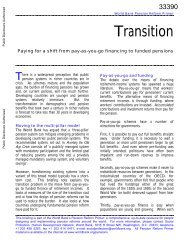Financial Sector Development in Africa: Opportunities ... - World Bank
Financial Sector Development in Africa: Opportunities ... - World Bank
Financial Sector Development in Africa: Opportunities ... - World Bank
You also want an ePaper? Increase the reach of your titles
YUMPU automatically turns print PDFs into web optimized ePapers that Google loves.
Microf<strong>in</strong>ance <strong>in</strong> <strong>Africa</strong> 11<br />
A Special Focus on Female Borrowers <strong>in</strong> <strong>Africa</strong><br />
One of the most obvious reasons why microf<strong>in</strong>ance has focused on<br />
women, especially <strong>in</strong> its <strong>in</strong>fancy, is the disproportionate effect of poverty<br />
on them. In <strong>Africa</strong> overall, the median ratio of women to total borrowers<br />
has been constantly above 50 percent and peaked around 78 percent,<br />
both <strong>in</strong> 2005 and <strong>in</strong> 2010 (figure 1.3). While these ratios were lower <strong>in</strong><br />
Lat<strong>in</strong> America and the Caribbean (65 percent) and the Middle East<br />
(46 percent) <strong>in</strong> 2010, they were higher <strong>in</strong> South Asia and <strong>in</strong> Europe and<br />
Central Asia, at 80 percent and 99 percent, respectively. On the subregional<br />
level, only North and Southern <strong>Africa</strong>n MFIs cater to more women<br />
than the cont<strong>in</strong>ent-wide median MFI.<br />
Urban versus Rural Supply of Microf<strong>in</strong>ance<br />
Microf<strong>in</strong>ance has been applauded for reach<strong>in</strong>g <strong>in</strong>to areas and provid<strong>in</strong>g<br />
access to customers that other f<strong>in</strong>ancial services have left out. All across<br />
<strong>Africa</strong>, the rural population is vastly underserved by f<strong>in</strong>ancial <strong>in</strong>stitutions.<br />
Unfortunately, thus far microf<strong>in</strong>ance has not been the exception to this<br />
trend. Accord<strong>in</strong>g to data from the Consultative Group to Assist the Poor<br />
(CGAP) and <strong>World</strong> <strong>Bank</strong> (2010) on branches across <strong>Africa</strong>, the distribution<br />
of rural microf<strong>in</strong>ance services—such as ATMs and POS locations—is<br />
rather slim compared with urban ones (see figure 1.4).<br />
Figure 1.3 Ratio of Women to Total Borrowers, 2005–10<br />
120<br />
100<br />
80<br />
Percent<br />
60<br />
40<br />
20<br />
0<br />
2005<br />
2006<br />
2007<br />
Year<br />
2008<br />
2009<br />
2010<br />
Central <strong>Africa</strong> East <strong>Africa</strong> North <strong>Africa</strong><br />
Southern <strong>Africa</strong> West <strong>Africa</strong> <strong>Africa</strong><br />
Source: MIX Market database 2012, http://www.themix.org/publications/mix-microf<strong>in</strong>ance-world.<br />
Note: All figures provided by MIX Market represent trends because not all MFIs <strong>in</strong> a country report to the<br />
database. Data represent subregional medians.







